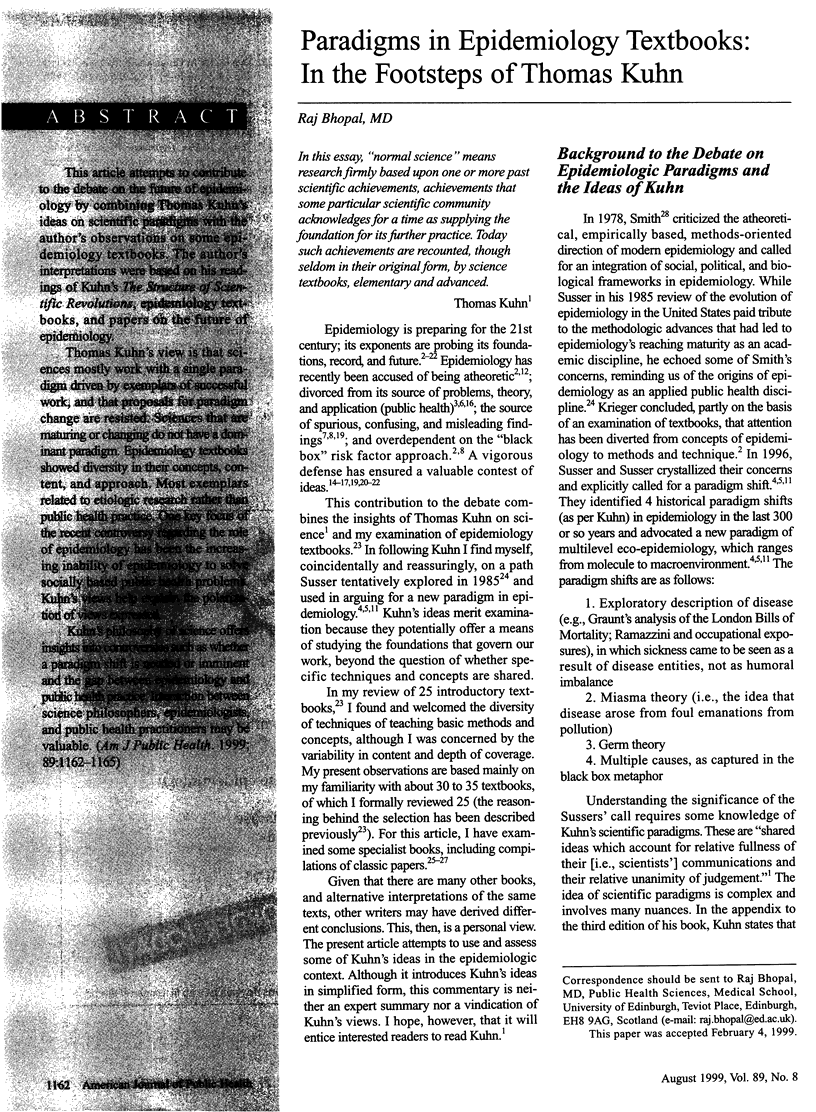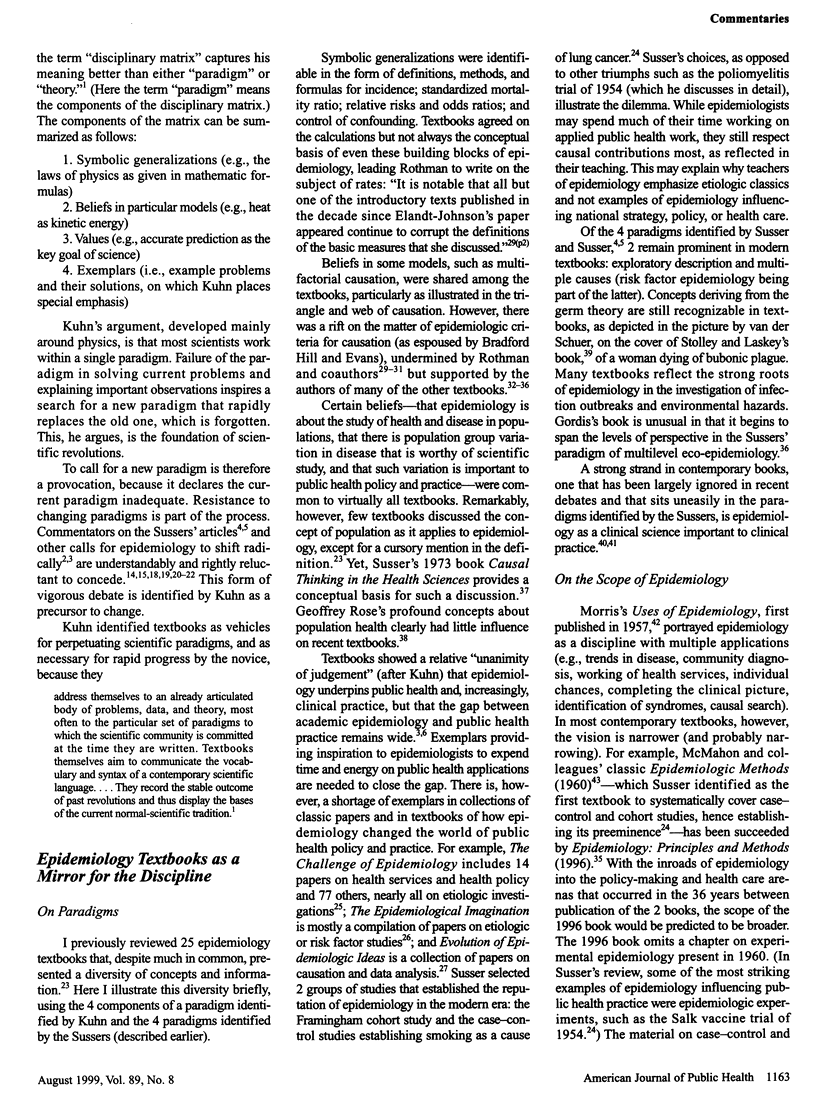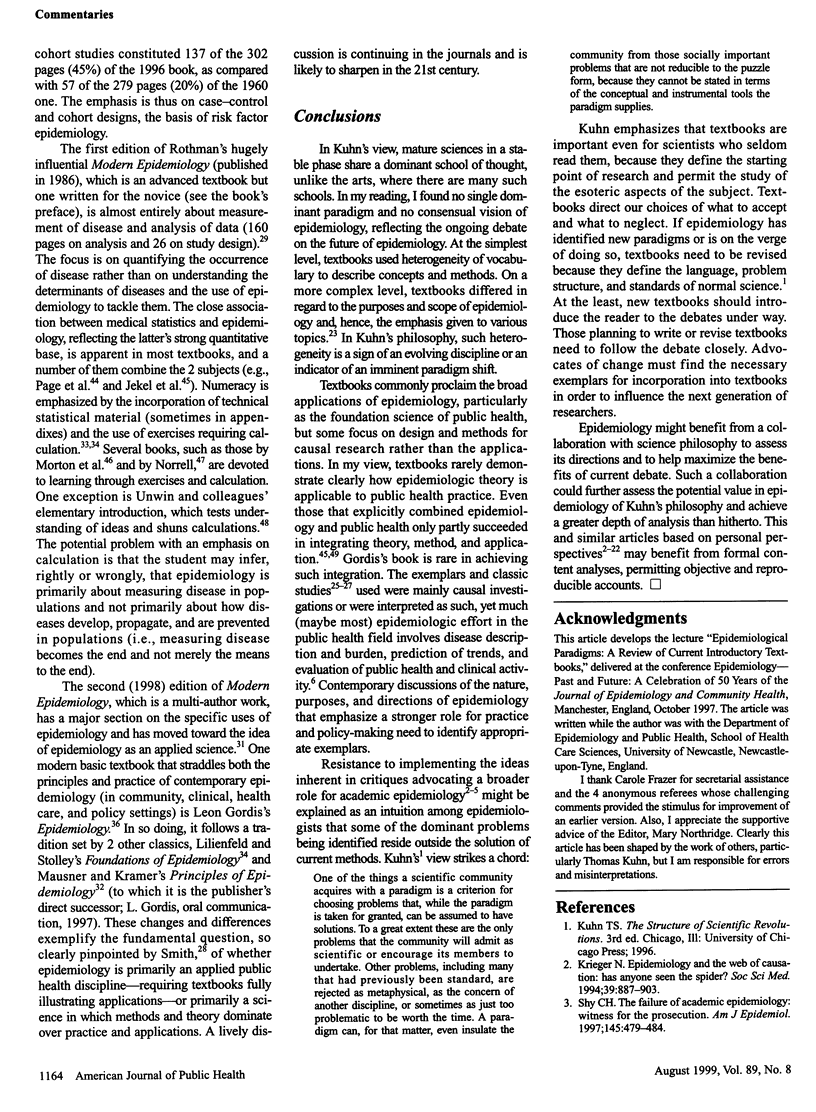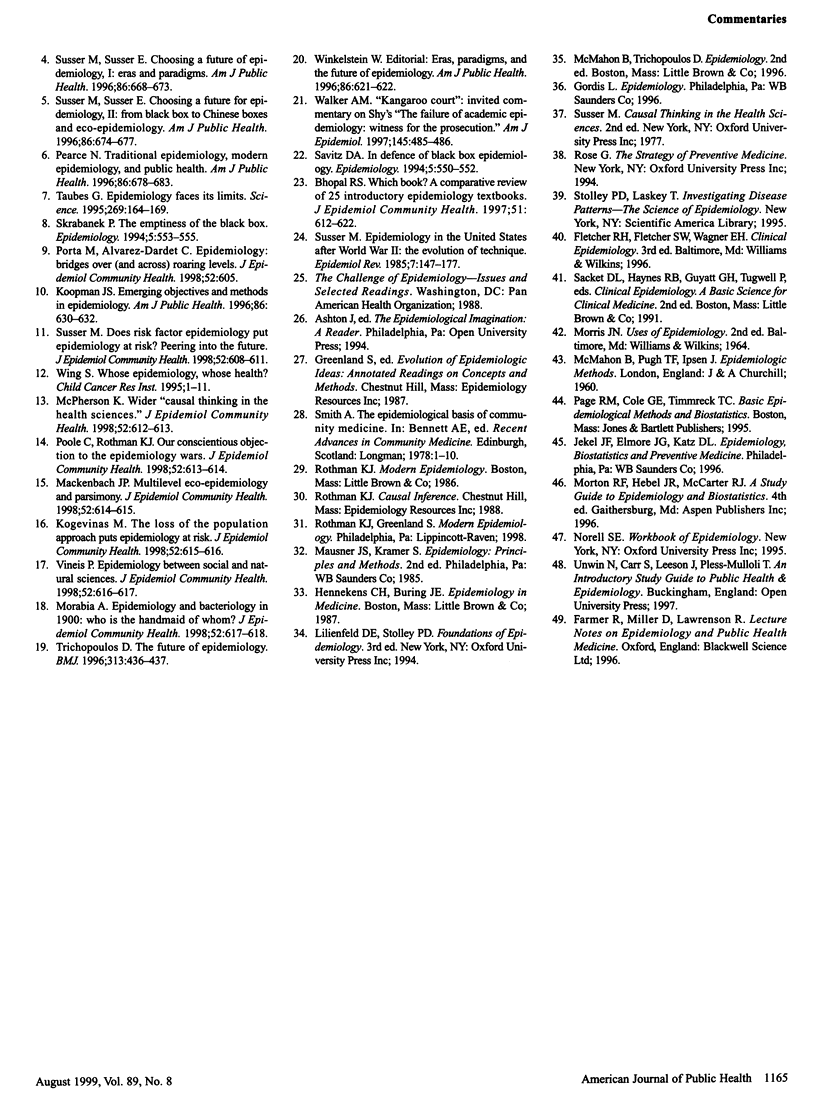Abstract
This article attempts to contribute to the debate on the future of epidemiology by combining Thomas Kuhn's ideas on scientific paradigms with the author's observations on some epidemiology textbooks. The author's interpretations were based on his readings of Kuhn's The Structure of Scientific Revolutions, epidemiology textbooks, and papers on the future of epidemiology. Thomas Kuhn's view is that sciences mostly work with a single paradigm driven by exemplars of successful work, and that proposals for paradigm change are resisted. Sciences that are maturing or changing do not have a dominant paradigm. Epidemiology textbooks showed diversity in their concepts, content, and approach. Most exemplars related to etiologic research rather than public health practice. One key focus of the recent controversy regarding the role of epidemiology has been the increasing inability of epidemiology to solve socially based public health problems. Kuhn's views help explain the polarization of views expressed. Kuhn's philosophy of science offers insights into controversies such as whether a paradigm shift is needed or imminent and the gap between epidemiology and public health practice. Interaction between science philosophers, epidemiologists, and public health practitioners may be valuable.
Full text
PDF



Selected References
These references are in PubMed. This may not be the complete list of references from this article.
- Bhopal R. Which book? A comparative review of 25 introductory epidemiology textbooks. J Epidemiol Community Health. 1997 Dec;51(6):612–622. doi: 10.1136/jech.51.6.612. [DOI] [PMC free article] [PubMed] [Google Scholar]
- Kogevinas M. The loss of the population approach puts epidemiology at risk. J Epidemiol Community Health. 1998 Oct;52(10):615–616. doi: 10.1136/jech.52.10.615. [DOI] [PMC free article] [PubMed] [Google Scholar]
- Koopman J. S. Emerging objectives and methods in epidemiology. Am J Public Health. 1996 May;86(5):630–632. doi: 10.2105/ajph.86.5.630. [DOI] [PMC free article] [PubMed] [Google Scholar]
- Krieger N. Epidemiology and the web of causation: has anyone seen the spider? Soc Sci Med. 1994 Oct;39(7):887–903. doi: 10.1016/0277-9536(94)90202-x. [DOI] [PubMed] [Google Scholar]
- Mackenbach J. P. Multilevel ecoepidemiology and parsimony. J Epidemiol Community Health. 1998 Oct;52(10):614–615. doi: 10.1136/jech.52.10.614. [DOI] [PMC free article] [PubMed] [Google Scholar]
- McPherson K. Wider "causal thinking in the health sciences". J Epidemiol Community Health. 1998 Oct;52(10):612–613. doi: 10.1136/jech.52.10.612. [DOI] [PMC free article] [PubMed] [Google Scholar]
- Morabia A. Epidemiology and bacteriology in 1900: who is the handmaid of whom? J Epidemiol Community Health. 1998 Oct;52(10):617–618. doi: 10.1136/jech.52.10.617. [DOI] [PMC free article] [PubMed] [Google Scholar]
- Pearce N. Traditional epidemiology, modern epidemiology, and public health. Am J Public Health. 1996 May;86(5):678–683. doi: 10.2105/ajph.86.5.678. [DOI] [PMC free article] [PubMed] [Google Scholar]
- Poole C., Rothman K. J. Our conscientious objection to the epidemiology wars. J Epidemiol Community Health. 1998 Oct;52(10):613–614. doi: 10.1136/jech.52.10.613. [DOI] [PMC free article] [PubMed] [Google Scholar]
- Porta M., Alvarez-Dardet C. Epidemiology: bridges over (and across) roaring levels. J Epidemiol Community Health. 1998 Oct;52(10):605–605. doi: 10.1136/jech.52.10.605. [DOI] [PMC free article] [PubMed] [Google Scholar]
- Savitz D. A. In defense of black box epidemiology. Epidemiology. 1994 Sep;5(5):550–552. [PubMed] [Google Scholar]
- Shy C. M. The failure of academic epidemiology: witness for the prosecution. Am J Epidemiol. 1997 Mar 15;145(6):479–487. doi: 10.1093/oxfordjournals.aje.a009133. [DOI] [PubMed] [Google Scholar]
- Skrabanek P. The emptiness of the black box. Epidemiology. 1994 Sep;5(5):553–555. [PubMed] [Google Scholar]
- Susser M. Does risk factor epidemiology put epidemiology at risk? Peering into the future. J Epidemiol Community Health. 1998 Oct;52(10):608–611. doi: 10.1136/jech.52.10.608. [DOI] [PMC free article] [PubMed] [Google Scholar]
- Susser M. Epidemiology in the United States after World War II: the evolution of technique. Epidemiol Rev. 1985;7:147–177. doi: 10.1093/oxfordjournals.epirev.a036280. [DOI] [PubMed] [Google Scholar]
- Susser M., Susser E. Choosing a future for epidemiology: I. Eras and paradigms. Am J Public Health. 1996 May;86(5):668–673. doi: 10.2105/ajph.86.5.668. [DOI] [PMC free article] [PubMed] [Google Scholar]
- Susser M., Susser E. Choosing a future for epidemiology: II. From black box to Chinese boxes and eco-epidemiology. Am J Public Health. 1996 May;86(5):674–677. doi: 10.2105/ajph.86.5.674. [DOI] [PMC free article] [PubMed] [Google Scholar]
- Taubes G. Epidemiology faces its limits. Science. 1995 Jul 14;269(5221):164–169. doi: 10.1126/science.7618077. [DOI] [PubMed] [Google Scholar]
- Trichopoulos D. The future of epidemiology. BMJ. 1996 Aug 24;313(7055):436–437. doi: 10.1136/bmj.313.7055.436. [DOI] [PMC free article] [PubMed] [Google Scholar]
- Vineis P. Epidemiology between social and natural sciences. J Epidemiol Community Health. 1998 Oct;52(10):616–617. doi: 10.1136/jech.52.10.616. [DOI] [PMC free article] [PubMed] [Google Scholar]
- Winkelstein W., Jr Eras, paradigms, and the future of epidemiology. Am J Public Health. 1996 May;86(5):621–622. doi: 10.2105/ajph.86.5.621. [DOI] [PMC free article] [PubMed] [Google Scholar]


